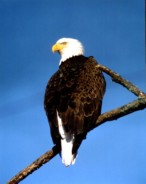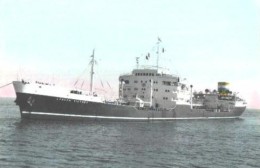
The mystery of the American Eagle |

The "London Victory" was an eight year old tanker at the time, we were anchored off Perth Amboy, New York USA discharging into barges to reduce our draught sufficiently to allow us to go alongside the berth and complete our discharge of Venezuelan crude oil. The Captain, George Fox a large jovial sober man from the North East coast was affectionately called "father" by his officers was taken ill as we moved ship at around midnight 18th September 1960 and a naval surgeon had to be called, he diagnosed that "father" had suffered a stroke and he persuaded Captain Fox that he should be hospitalised for two weeks. He could rejoin us after we had done a further voyage to Venezuela to load crude oil for the USA. The surgeon was a most persuasive man showing Capt.Fox it was essential for his own health, the company good, and a practical demonstration of his confidence that, we, the ships officers had learnt what Capt. Fox had taught us. We had an uneventful voyage to load at San Lorenzo on Maracaibo lake and no excitement on the return voyage to the USA, that is until the 6th Oct. 1960 when we were proceeding into Chesapeak Bay. Some 3 hours before we picked up the pilot we had and American white tailed fish eagle perch on our foremast, this excited the amateur ornithologists on board who had never seen on before, myself included. The pilot when he boarded told us that the Agents had asked him to tell us that Captain Fox had died earlier that morning. Once the pilot "had the con" the eagle left and we proceeded inward to our berth at Paulsboro some 10 miles down river from Philadelphia. We thought no more about the eagle whilst we discharged. The next day 7th Oct. we sailed seaward, but as the pilot was about to leave the ship, the eagle again perched on the foremast - a coincidence only, we thought. Our destination for loading was again Venezuela, this time Cabimas and for the full voyage of 1,710 miles and for 7 days the eagle stayed on the foremast, maintaining its position, looking aft, down into the bridge, its back horizontal, head moving side to side. With the wind from ahead ruffling its feathers a most unusual attitude for a bird to adopt, we thought.On the 13th October we reach E.M.I. buoy and picked up a pilot. The eagle chose this time to leave the ship and we thought that this would be the last we would see of it. Wrong again, because two days later when we had loaded in Maracaibo lake and were proceeding seaward, as we dropped the pilot the eagle resumed its perch on our foremast. Why we thought? the area was crowded with ships of all sizes, the local fishing was plentiful and should have been attractive to a hungry fish eagle. By now the third officer was frightened to go on the wing of the bridge to take sights and bearings and had taken to coming on to and leaving the bridge by way of the inside of the accommodation . He had to be told that "George" as we had come to call the eagle was only looking after us and we had nothing to fear, as long as we did our jobs properly. The eagle had by now become a major topic of conversation, only twice had we seen it leave the foremast, short flight around the vessel of a few minutes duration, never seen to eat, always looking in the bridge . At night periodically we had got into the habit of shining the aldis lamp onto the Foremast to check if he was still there - he always was, always facing the bridge. This continued until we had cleared the islands on our way towards Rotterdam. He stayed on sentinel duties until we were in deep traffic free waters for a period of 36 hours before it eventually flew away on the 17th October 1960. Having done its job of looking after us? |
THE UNEXPLAINED PRESENCE OF THE AMERICAN EAGLE (American white tailed fish eagle.) PEOPLE INVOLVED. Captain G Fox Chief Officer Hubbard Second Officer R E Ambrose Jones Third Officer Pettifer Quartermasters and crew Motor Tanker "London Victory " Period 6th to 17th October 1960 Appearances 3 (3 hours + 6 days + 3 days Duration 9+ days Distance covered 2,755 nautical miles |
